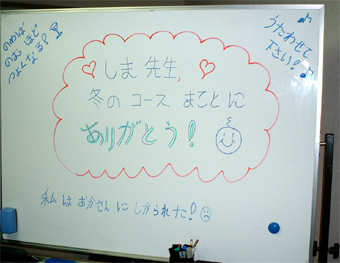 SIL Class Level Description
SIL Class Level Description
In all SIL classes, students should express their own ideas in Japanese.
Please note that a good knowledge of Elementary II level is enough for challenging JLPT N-4 (old JLPT level 3),
and for some students to be able to pass it.
ELEMENTARY LEVEL
Develop basic conversation skills.
Learn to express yourself more freely in Japanese.
Please note Kanji are used in study materials as appropriate but will not specifically be taught during classes.
Beginner
Zero starter. Student's first stay in Japan and first time studying Japanese.
Elementary I
Has stayed in Japan for at least half a year; can listen to and understand spoken Japanese.
Aims for the ability to converse in simple sentences using basic verb and particle patterns, not broken Japanese,
as well as being able to appropriately use adjectives in all tenses.
Students at this level are expected to have a target of around 100 kanji and a vocabulary of 500 words.
Aiming for the N-5 level of the Japanese Proficiency Exam (old JLPT 4).
Elementary II
Has successfully completed JBP Vol. 1 or Minna no Nihongo and the N-5 level of the Japanese Proficiency Exam (old JLPT 4).
Aiming for the ability to use correct particles and construct the correct sentence patterns,
and read short sentences (ex. Minna no NihongoII. ~L40).
Students at this level are expected to have a target of around 200 kanji and a vocabulary of 800 words.
Challenging the N-4 level of the Japanese Proficiency Exam (old JLPT 3).
Elementary III
Has successfully completed the E-II level.
Targeting the volitional, passive, causative, giving/receiving patterns, the conditional patterns (nara; ba),
and other advanced level grammar and expressions;
can with relative ease, freely express one's ideas (for example, asking for information on the telephone,
making and declining requests).
Ability to read and write short sentences and simple long sentences.
Targeting kanji of 300 and vocabulary of 1,500.
Aiming for getting more than 80% of the N-4 level of the Japanese Proficiency Exam (old JLPT 3).
INTERMEDIATE LEVEL
Intermediate I
Has successfully completed all elements of elementary grammar.
Using this as a foundation, can use high level grammar and simple idiomatic expressions
in useful every day life conversations and situational explanations, ability to read and write simple sentences.
Has passed the N-4 level of the Japanese Proficiency Exam (old JLPT 3),
first attempt at the N-3 or N-2 level of the Japanese Proficiency Exam (old JLPT 2).
Intermediate I Conversation
Same as above but not aiming for passing the proficiency exam.
Goal of simply improving conversation and hearing skills.
Intermediate II
Has successfully completed the I-I level. Ability to freely express oneself satisfactorily,
utilizing expressions and patterns learned at the I-I level.
Targeting kanji of 1,000 and vocabulary of 6,000.
Has previously studied for the N-2 level of the Japanese Proficiency Exam (old JLPT 2).
Second attempt at the N-2 level (old JLPT 2).
ADVANCED LEVEL
Advanced I
Using high level grammar and idioms, can talk about and exchange ideas regarding social issues,
ability to read the newspaper, essays and novels, and write essays.
Targeting kanji of 2,000 and vocabulary of 10,000. Has passed the N-2 level of the Japanese Proficiency Exam (old JLPT 2),
first attempt at the N-1 level of the Japanese Proficiency Exam (old JLPT 1).
Advanced II
Has successfully completed A-I and can freely use those expressions,
ability to arrive at a high-level proficiency usage
(for example, ability to discuss and deliberate social and current affairs, read and write a thesis).
Has studied for and/or taken the N-1 level of the Japanese Proficiency Exam (old JLPT 1), second attempt at the N-1 level (old JLPT 1),
or has successfully passed the N-1 level (old JLPT 1).
** SIL will determine class placement depending on the results of interviews, placement tests and class trials.
For elementary level students, after the selected course has started,
any request for course changes will be accepted only once. However; for intermediate and advanced level students,
request for changes in the class schedule (reading comprehension, listening comprehension, kanji, vocabulary, grammar)
will be granted only after consultation with the instructor, and as long as it will not be an inconvenience
to other students involved.
 SIL Class Level Description
SIL Class Level Description